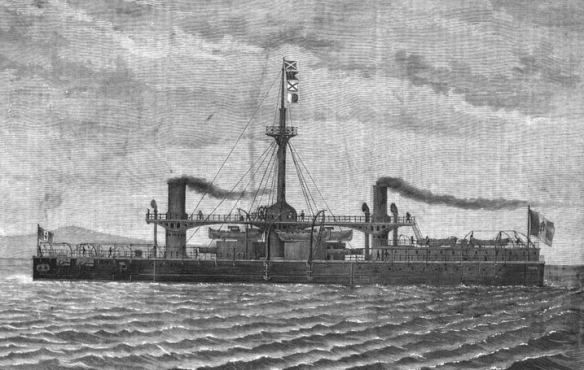
History |
|
|---|---|
| Name: | Caio Duilio |
| Namesake: | Gaius Duilius |
| Laid down: | 6 January 1873 |
| Launched: | 8 May 1876 |
| Completed: | 6 January 1880 |
| Fate: | Hulked, 1909 |
General characteristics |
|
| Class and type: | Caio Duilio-class ironclad battleship |
| Displacement: |
|
| Length: | 109.16 m (358 ft 2 in) |
| Beam: | 19.74 m (64 ft 9 in) |
| Draft: | 8.31 m (27 ft 3 in) |
| Installed power: |
|
| Propulsion: | Two compound steam engines |
| Speed: | 15.04 knots (27.85 km/h; 17.31 mph) |
| Range: | 3,760 nmi (6,960 km) at 10 kn (19 km/h; 12 mph) |
| Complement: | 420 |
| Armament: |
|
| Armor: |
|
Italian naval administrator and engineer; considered the father of the modern Italian navy. Born on 17 May 1833 in Turin, Benedetto Brin in August 1853 became a naval engineering cadet with the Sardinian navy at Genoa. The following year, Count Camillo di Cavour arranged a two-year graduate assignment for Brin in Paris, at the prestigious École d’Application du Génie Maritime, which proved a turning point in his professional life.
Brin was then posted to the naval shipyard at Foce; he also taught naval mechanics at the Royal Naval School in nearby Genoa. His association with the Orlando brothers, who were building some of the first iron-hulled ships, added to his shipbuilding experience. In 1863 Brin was named the navy minister’s consultant on naval construction, and in 1867 he reported to the High Council of the Italian navy as a division chief, using the office to further study the work of pivotal naval design theorists such as Stanislas Dupuy de Lome, Louis de Bussy, Edward J. Reed, Nathaniel Barnaby, and William H. White.
In designing a powerful new warship for an Italian navy still smarting from its defeat in the Battle of Lissa in 1866, Brin fixed on some basic elements: a main armament consisting of four large-caliber cannons in two armored turrets diagonally distributed amidships; essential vertical armor protection of the central citadel, with extensive secondary protection; and an internal compartmentation capable, most importantly, of keeping the ship afloat despite severe damage. This formula would dictate development of the new battleships Caio Duilio and Enrico Dandolo. When the Duilio went to sea in 1880, it was the most striking and powerful ship of its kind in the world, incorporating unmatched levels of offensive and defensive capability, plus unprecedented speed.
Brin’s warship innovations continued with the development of the larger battleships the Italia, the Ruggiero di Lauria, and the Re Umberto, as well as smaller vessels like the Garibaldi-class armored cruisers, the destroyer types Tripoli, Folgore, and Partenope, and the ram Fieramosca. Many of these designs anticipated foreign developments by 10 years or more.
Appointed undersecretary of state for the naval ministry by Admiral Simone Antonio Pacoret de Saint Bon, Brin succeeded him as naval minister during 1876-1878; he also served in the same post during 1884-1891 and 1896-1898. In his second term he oversaw the organization of a new Italian mechanical and metallurgical industry that included steelworks, gun foundries, and torpedo factories capable of supplying shipyards with domestically produced steel and components. Brin established the Royal Naval Academy at Livorno in 1881, and he was promoted to inspector general of naval engineering; he inaugurated construction of a new model test basin for shipbuilding research at the La Spezia naval arsenal.
Benedetto Brin oversaw an unprecedented naval renaissance that for a brief period in 1895 placed Italy third among world navies. He died in Rome on 24 May 1898.
References
Brin, Benedetto. La Nostra Marina Militare. Rome: Bocca, 1881.
Dizionario Biografico degli Italiani. Vol. 14. Rome: Istituto Enciclopedia Italiana, 1972.
Ferrante, Ezio. Benedetto Brin e la Questione Marittima Italiana, 1866–1898. Rome: Rivista Marittima, 1983.